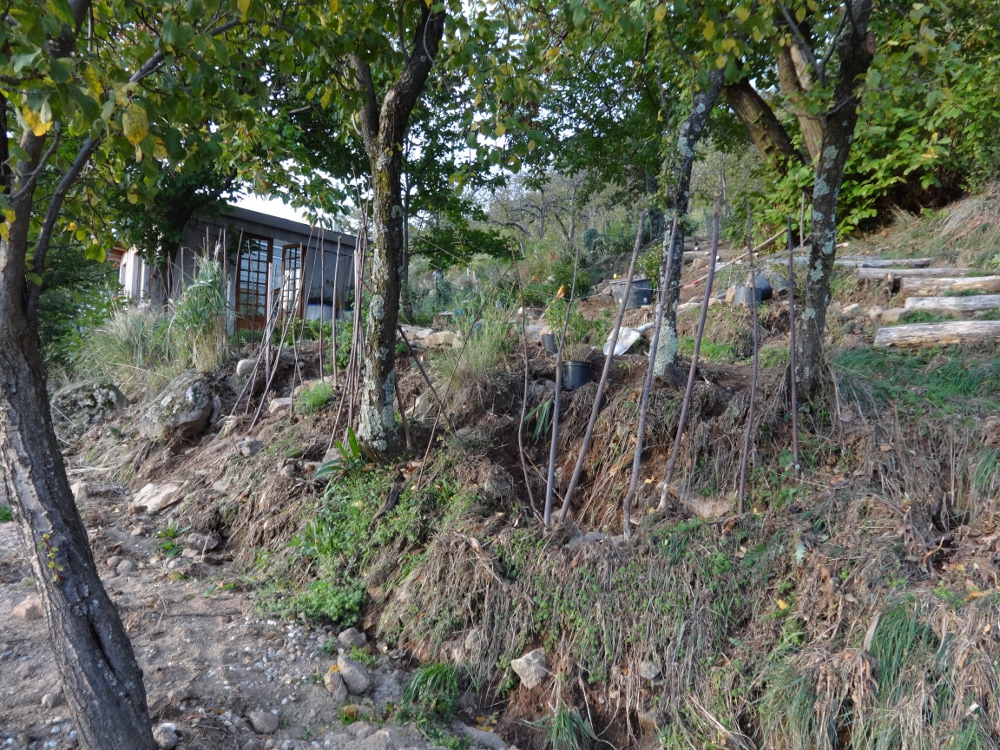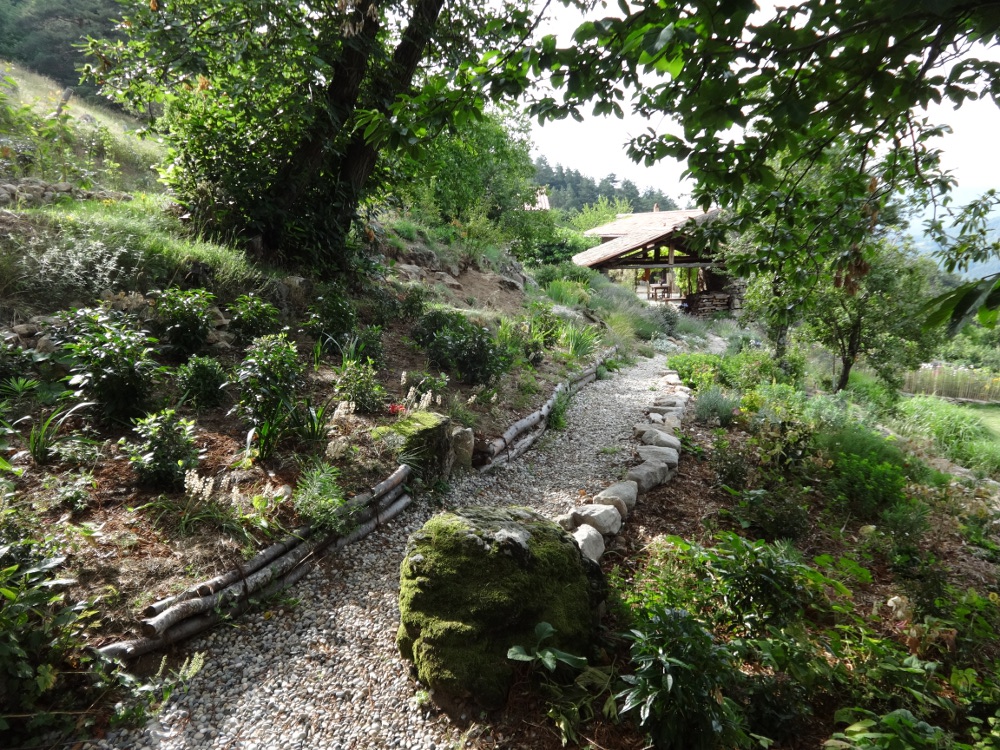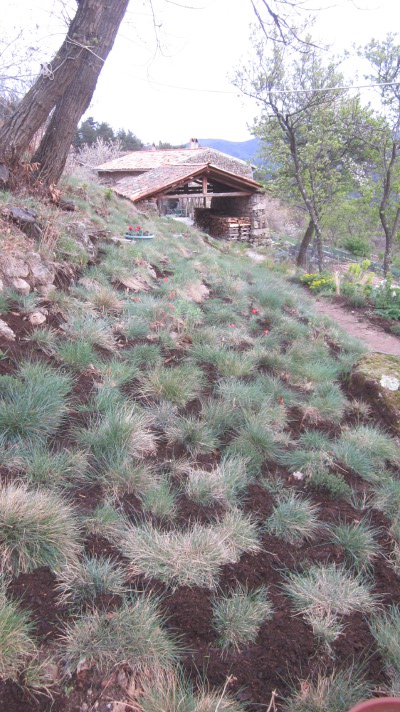The shade garden – learning from garden design mistakes
 The big one. Well not in terms of size. This part of the farm is what I call the shade garden. It measures about 40 feet by 20 feet and is just in front of my potting shed.
The big one. Well not in terms of size. This part of the farm is what I call the shade garden. It measures about 40 feet by 20 feet and is just in front of my potting shed.
And never was there a trickier and more mucked about landscaping scheme going on in this space.
 When we finally cleared the brambles and took down the rickety fencing with chicken wire, there was a small deer track leading up to the chook shed and going nowhere else. At the far end of the property, the shed is very close to the boundary of our farm.
When we finally cleared the brambles and took down the rickety fencing with chicken wire, there was a small deer track leading up to the chook shed and going nowhere else. At the far end of the property, the shed is very close to the boundary of our farm.
And believe me, it was a perfect example of someone not knowing what they were doing. Step forward the guilty party.
I had come fresh from England, full of garden schemes and ideas all suited to a soft gentle climate. And did I even bother to find out just how tricky this part of the garden was?
 Hah. Two huge chestnut trees above, dry as dust. Some parts deep shade, others in blazing sunshine. Poor soil quality. Rocks, killer chestnut burrs. You name it I had it. And at the lower end, a thicket of plum trees which threw up more suckers than you could trip over.
Hah. Two huge chestnut trees above, dry as dust. Some parts deep shade, others in blazing sunshine. Poor soil quality. Rocks, killer chestnut burrs. You name it I had it. And at the lower end, a thicket of plum trees which threw up more suckers than you could trip over.
I still do.
 But I will say this in praise of novice gardeners; we never lack for enthusiasm and energy. And I took to this project with gusto in 2008.
But I will say this in praise of novice gardeners; we never lack for enthusiasm and energy. And I took to this project with gusto in 2008.
The first thing I had to do was find my way through. Each autumn this plot gets a huge carpet of chestnut burrs and nuts, all of which try to turn into little trees.
 So I learned early on to use gloves whenever I was clearing stones and trying to do over the mess. And to pull up chestnut seedlings At Once. I still do.
So I learned early on to use gloves whenever I was clearing stones and trying to do over the mess. And to pull up chestnut seedlings At Once. I still do.
In fact you might find that every time I walk up to the potting shed I tend to veer off the path and bend down and yank out the easy to remove baby seedlings. Once they get over a foot high you have to dig.
 There were some collapsed walls here. I ran out of funds and wall builders to get the wall completed at the very front of the garden. It faces a path we created and looks down onto the swimming pool on the terrace below.
There were some collapsed walls here. I ran out of funds and wall builders to get the wall completed at the very front of the garden. It faces a path we created and looks down onto the swimming pool on the terrace below.
So instead I moved the rocks and thought about planting up a bank of grasses. Calamagrostis Karl Foerster.
 A big mistake in this incredibly dry place. They grew tall and spindly and took on the same look as my five uncles standing at Dee Why beach in the 1940s. The family called it the Biafran Famine Photo. The grasses came out after three years.
A big mistake in this incredibly dry place. They grew tall and spindly and took on the same look as my five uncles standing at Dee Why beach in the 1940s. The family called it the Biafran Famine Photo. The grasses came out after three years.
 So cleared ground. Now what? I know, I have just been with Andrew and Peppi to Great Dixter Garden in England. Of course, I’ll copy some of Christopher Lloyd planting schemes. Polychromas, myosotis. Lupins.
So cleared ground. Now what? I know, I have just been with Andrew and Peppi to Great Dixter Garden in England. Of course, I’ll copy some of Christopher Lloyd planting schemes. Polychromas, myosotis. Lupins.
The lupins lasted a season. The myosotis (forget-me-not) held on for two seasons before I came round to realising what twee sight it was.
Under the green gauge plum trees. Looking frankly suburban. And only saved by the lush growth of the euphorbia polychromas in between.

I weeded diligently. Mulched like mad. And I was slowly bringing a bit of goodness to the soil. But I still lacked direction.
And you would think that the most glaringly obvious thing would have been to have put some structure in here.



I knew I was floundering with the design so I decided to look for a local solution.
This mountain is covered in a blue tussocky grass called festuca glauca. A good self-seeder, it finds purchase on just about any rock or steep slope.
So I decided to clear the top part of the shade garden and transplant weeds instead. And that was fun. Especially when it came to the design. It was heave out with the grasses, stagger down the slope, scrape a bit of soil and dump them in place. The easiest gardening you could do.

I missed strimming them back in the Spring because I was so taken with how fetching they were. And Artur loved hiding in what soon became a jungle. A self-seeding jungle.
I couldn’t keep the weeds out of the shade garden on the other side.
I hauled them out after just one year. And then it was time to do some proper thinking.

Mainly because I was carefully watching the hedge I had planted up on the road, above the potting shed. There were some plants that seemed to be bomb proof. Viburnum tinus and prunus lusitanica (Portuguese laurel). Both stellar plants.

And I realised too that I couldn’t just change one side of the garden with the path in between. I needed a radical rehaul.
I vividly remember Andrew standing in the middle of the mess of the garden and saying with great kindness ‘this bed could do with a bit of editing’. What a diplomat.
He came up with some ideas for interplanting other fun things among the sensible shrubs: more euphorbias, particularly Mrs Robbs’ Bonnet, irises, some Hemerocallis, some hellebores.

I had planted up half. And put in almost 1000 bulbs in between.
All this happened last October, 2013. And if you look back through the archives for that month you will see that something momentous happened to this farm on the 24th.
We had a catastrophic flood.

I won’t bore you with too many action shots of most of my shrubs, freshly planted, rolling and tumbling down the mountain and ending up in the swimming pool. Followed swiftly by all the topsoil.

But actually with incredible help it’s better than before. It just took an awful lot of work. And it’s heartbreaking to stand and look at what was once a garden and wonder how on earth one could get it back. But I did it a bucket at a time.
And the lovely employee at Vachon plant nursery just nodded and smiled when I went back and back for more shrubs. I think my tally was over 60 small trees by the end of winter. Thank goodness they are cheap.

He built a low wall on the lower side of the shade garden path. And I had some logs hanging about which he stacked to make a top edge to the path. Gravel was scraped off the lawn and put back.
And I managed to get enough soil out of the swimming pool to recreate the beds.

I was so fearful every time it rained for about two months. I wanted to get any plant in with good roots to hold the soil in place.

I didn’t have time to build a low wall here out of stone, so I went into the forest and cut down some fat and slightly curving chestnut trees.
I tell you I was in a frontiers-woman mode. Nothing was going to stop me rebuilding this eyesore of a natural disaster. I worked like mad.

Thank goodness this summer had been damp and cool. It means that all my shrubs have had a chance to settle in and put on growth without being too stressed.
Now when I stand in my potting shed and look out onto this very challenging garden bed I can smile at last and think it is going in the right direction. If we don’t get another flood and I can get some stress-free seasons, this might just end up the way I want it: a modern take on a Victorian shrubbery. Green and cool and neatly landscaped. If I had known this is what would suit this part of the garden when I started, I would have saved myself years of trouble. But it’s all gardening, and it’s all fun.
***

It worked. My shrubbery lives. And thrives.

For those of you contemplating a garden in such dry conditions, I can’t recommend some plants more highly. The viburnum and the portuguese laurel, of course. They are the stalwarts here.
But I was pleased and delighted how well the iris foetidissima has fared. It won’t self-seed, but at least it is bulking out the area.
The euphorbia is the king of self-seeders. The wulfeniis are marvellous at romping. And I thought the Robbie would do the same. But they suffer from the heat and drought more than other euphorbias. But they spread. So they cover the ground.
Whether you want them to or not.
But that’s fine. When they spread to the path I just yank them out. And they add to the green in such a vibrant, dark green glossy way.
The one design change I made was to expand the planting. I found the area a bit ‘tight’ with vegetation and bare further up the bank.
This area rises to encompass Sarah’s path and another hedge area. So I have blended the boundaries with more shrubs on the top of the bank.







